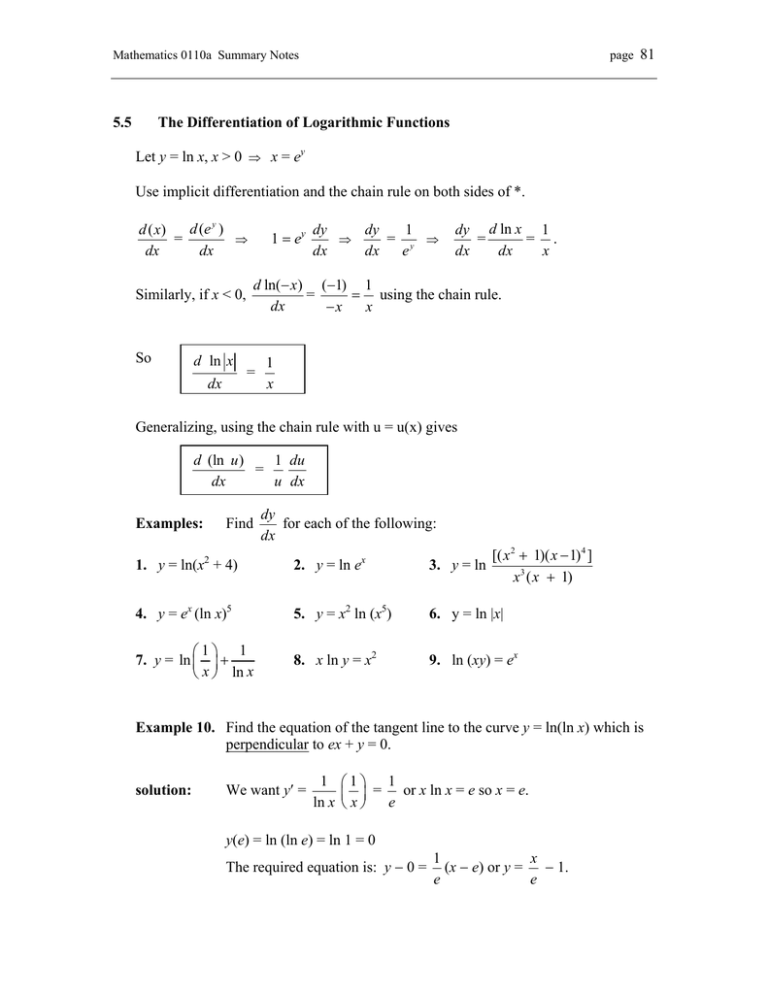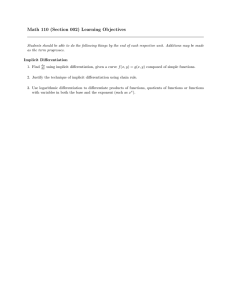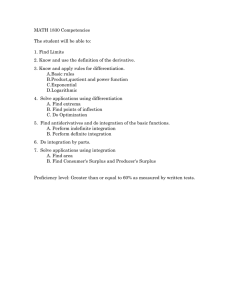5.5 The Differentiation of Logarithmic Functions Let y = ln x, x > 0
advertisement

page 81 Mathematics 0110a Summary Notes 5.5 The Differentiation of Logarithmic Functions Let y = ln x, x > 0 ⇒ x = ey Use implicit differentiation and the chain rule on both sides of *. d (e y ) d ( x) = ⇒ dx dx Similarly, if x < 0, So d ln x dx 1 = ey dy dy 1 ⇒ = y ⇒ e dx dx dy d ln x 1 = = . x dx dx d ln(− x) (−1) 1 = = using the chain rule. dx −x x = 1 x Generalizing, using the chain rule with u = u(x) gives d (ln u ) 1 du = dx u dx Examples: Find dy for each of the following: dx [( x 2 + 1)( x − 1) 4 ] x3 ( x + 1) 1. y = ln(x2 + 4) 2. y = ln ex 3. y = ln 4. y = ex (ln x)5 5. y = x2 ln (x5) 6. y = ln |x| ⎛1⎞ 1 7. y = ln ⎜ ⎟ + ⎝ x ⎠ ln x 8. x ln y = x2 9. ln (xy) = ex Example 10. Find the equation of the tangent line to the curve y = ln(ln x) which is perpendicular to ex + y = 0. solution: We want y′ = 1 ⎛1⎞ 1 ⎜ ⎟ = or x ln x = e so x = e. ln x ⎝ x ⎠ e y(e) = ln (ln e) = ln 1 = 0 The required equation is: y − 0 = 1 x (x − e) or y = − 1. e e page 82 Mathematics 0110a Summary Notes • General Exponential Functions Consider once again, y = bx, where b > 0. x Change the base to e, y = e ln b = exln b. So y ′ = exln b (ln b) = bx ln b. d (b x ) = bx ln b dx Generalizing, using the chain rule with u = u(x) gives d (bu ) du = bu ln b dx dx Example 11. d 5x = 5 x ln 5 dx Example 12. d 10ln x ln10 = 10ln x dx x • General Logarithmic Functions Consider now, y = log b x , where b > 0. Then x = by by definition. Now use implicit differentiation. 1 = by ln b y ′ So y ′ = 1 1 = . b ln b x ln b y Mathematics 0110a Summary Notes page 83 Then d (log b x) 1 = dx x ln b . Generalizing, using the chain rule with u = u(x) gives d (log b u ) 1 du = dx u ln b dx Example 13. d log 5 x 1 = dx x ln 5 d log 2 ( x 2 + e x ) 2x + ex Example 14. = 2 x dx ( x + e ) ln 2 Another approach to developing the formulas above is simply to use the change of base formula. Recall, log b x = d ⎛ ln x ⎞ d (log b x) ln x 1 so = . ⎜ ⎟= dx ⎝ ln b ⎠ x ln b dx ln b With base b ≠ e, derivatives of general logs and exponentials proceed as before with the added term ln b. Obviously when b = e, ln b = ln e = 1 indicating once again why e is a natural base. Example 15. Given f(x) = log 4 (log 2 x) find f ′(16). solution: f ′(x) = d (log 4 (log 2 x) 1 1 1 = dx log 2 x x ln 2 ln 4 f ′(16) = 1 1 1 1 1 = 4 16 ln 2 ln 4 64 ln 2 ln 4 page 84 Mathematics 0110a Summary Notes • Logarithmic Differentiation The properties of logarithms make them useful tools for the differentiation of complicated functions that consist of products, quotients and exponential or combinations of these. • procedure: 1. determine whether log differentiation applies − expression is a combination of products, quotients, exponentials − sums and differences of terms are not eligible − y written explicitly in terms of x 2. take the natural log of both sides 3. simplify the rhs as much as possible using log properties 4. differentiate term by term (implicitly on the lhs) dy 5. solve for dx Example 16: Let y = 3x ( x 2 − 2)3 ( x + 3) (1 − x) x + 2 x 3 . Find dy . dx solution: 1. y is expressed solely in terms of products, quotients and exponentials. 2. ln y = ln 3x ( x 2 − 2)3 ( x + 3) (1 − x) x3 + 2 x 3. = x ln 3 + 3ln (x2 − 2) + ln (x + 3) − ln (1 − x) − (1/2) ln (x3 + 2x) 4. 5. 1 dy 2x 1 (−1) 1 3x 2 + 2 = ln 3 + 3 2 + − − y dx x − 2 x + 3 1 − x 2 x3 + 2 x ⎛ dy 2x 1 (−1) 1 3x 2 + 2 ⎞ = y ⎜ ln 3 + 3 2 + − − ⎟ dx x − 2 x + 3 1 − x 2 x3 + 2 x ⎠ ⎝ 3x ( x 2 − 2)3 ( x + 3) = (1 − x) x3 + 2 x ⎛ 6x 1 1 3x 2 + 2 ⎞ + + + − ln 3 ⎜ ⎟ x 2 − 2 x + 3 1 − x 2( x3 + 2 x) ⎠ ⎝ page 85 Mathematics 0110a Summary Notes In the last example, the application of ln to both sides converts products and quotients into sums and differences − simplifying the differentiation. Note that • d 1 dy ln y = on the lhs. dx y dx generalized exponentials The properties of logarithms also simplifies the differentiation of exponential expressions in which both the base and exponent are non−constant. Taking logarithms converts these expressions into simple products. Differentiation can then proceed using the product rule. Example 2: solution: Let y = x x + ln x . Find dy . dx 1. The expression is an exponential function. 2. ln y = ln x x + ln x 3. ln y = (x + ln x) ln x • 4. 1 dy 1 1 = (1 + ) ln x + (x + ln x) y dx x x 5. dy 1 1 2 = y [(1 + ) ln x + (x + ln x) ] = x x + ln x [ ln x + ln x + 1] x x x dx the power rule for real values of the exponent Let y = xr, where r is any real number. Use log differentiation. ln y = ln xr = r ln x 1 dy r = y dx x xr dy r = y = r = r x r −1 dx x x Therefore: d r du u = ru r −1 dx dx as expected. by applying the chain rule.


![[ln y] dy dx 2](http://s2.studylib.net/store/data/018302535_1-b746293f1349e81be2a778c9937d3ef7-300x300.png)